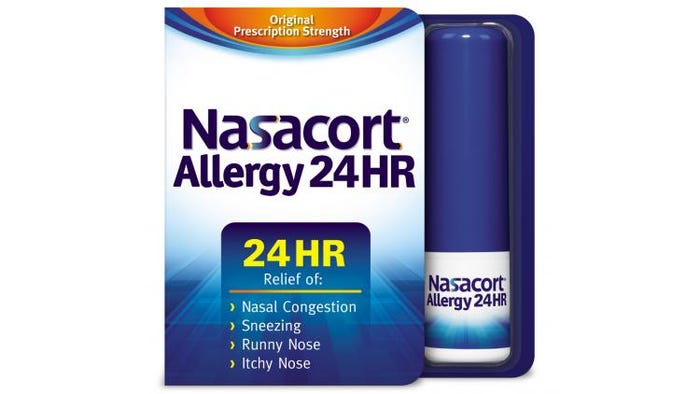Package redesign highlights benefits of Nasacort allergy spray
May 4, 2018
Over-the-counter medicine depends as heavily as any other consumer product on packaging shelf appeal. In a sense, on-package communication is even more important for OTC products than for foods or beverages, because taste rarely enters into the decision to buy; it’s all about benefits and effectiveness, which must be made clear to consumers.
A revamp of the packaging of an established OTC medicine must strike a balance between changing or reordering its benefit claims, and maintaining brand equity. In addition, visibility and ease of opening are important to shoppers.
That’s what Sanofi took into account when it redesigned the packaging for Nasacort, its nasal allergy spray. The new packaging emphasizes that Nasacort offers 24-hour relief and is non-drowsy, scent-free and alcohol-free. The logo is 35% larger, and the new packaging features a window that clearly displays two bottles, making the value proposition clear to consumers.
Whitney Barnes, associate brand manager at Sanofi, talks about the advantages of the redesign.
What exactly is the structure of the package?
Barnes: The package consists of six components, including a translucent thermoformed tray, a pressure-sensitive label listing the drug facts, an SBS (solid bleached sulfate) lid, a consumer leaflet, and the bottles and overcaps. The tray holds the product itself along with the consumer leaflet. The label with the drug facts is applied to the outside of the tray so that consumers can readily find this information. The lid is heat-sealed to the tray. When used, electronic security tags are applied to the back of the lid, so they do not come into contact with the bottles.
Consumer research proved it’s important for allergy sufferers to see the bottle contained with the package, so consumers can see the Nasacort bottles both through a window in the lid and through the translucent tray. Consumers also indicated they want to be able to open the package easily, without the use of scissors, so the tray is perforated to facilitate easy opening.
No changes were made to the bottles, bottle labels or overcaps during this process.
How does the package structure differ from the previous package?
Barnes: Key features of the new packaging include the use of a more modern design and structure. As mentioned above, the new packaging features a window that clearly displays two bottles, which makes Nasacort the only intranasal steroid (INS) to clearly display two bottles in its multipack so the value is easily visible to shoppers.
The new packaging also has a smaller footprint (0.5 inches narrower per facing), so that it is more easily merchandised at shelf. In addition, a new easy-open feature allows consumers to attain relief for their allergy symptoms faster and without the need for scissors, making it more user-friendly.
Overall, the new packaging is also made with stronger materials, including heavier plastic and reinforced edges, which will reduce wear and tear during shipping and result in fewer damaged packages. The sticker seal from the previous packaging has also been eliminated, which will prevent cartons from opening as they’re shipped from the warehouse to the retailer’s shelf.

The previous Nasacort packaging design (above) showed consumers just one bottle in the dual-sprayer pack.
You say that “research showed the new design may increase purchase choice by 19%, compared to the original design.” How can research determine something like that?
Barnes: Sanofi worked with AMC Global to conduct quantitative research with allergy sufferers as a way to test and secure consumer insight into different packaging designs, including their impact on shelf recall and purchase intent. AMC Global utilized the latest behavioral science research techniques using digital shop shelves and latent response time measurement to understand shelf standout.
***************************************************************************
Production efficiencies, ecommerce challenges, sustainability trends, new bioplastic technologies and more are among the topics on the agenda at the new Packaging Education Hub at EastPack 2018 (June 12-14; NYC). This free educational program will have more than 15 hours of can’t-miss presentations, demonstrations and hands-on activities. Register to attend for free today!
About the Author(s)
You May Also Like


